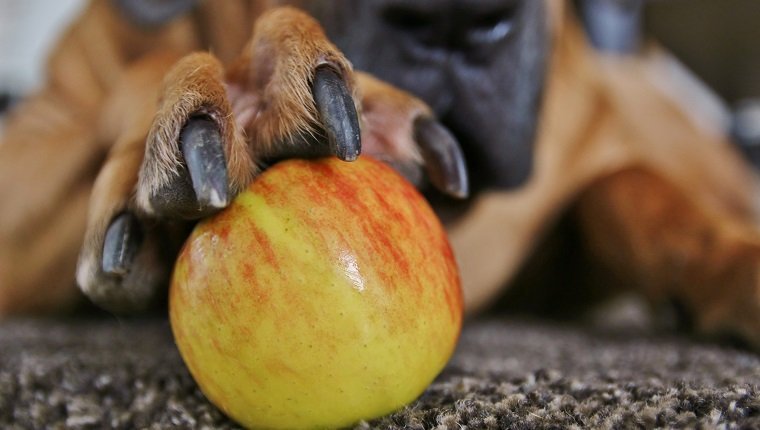(Picture Credit: Getty Images)
Can dogs eat apples? The short answer is yes, dogs can eat apples, but there are some things you should know before you feed them to your dog.
These fruits are full of nutrients that can be beneficial to your dog’s health, but there are some dangers to look out for, such as the cores and seeds. As with any good thing, moderation is the key because too many apples may cause gastrointestinal upset in dogs.
If you serve them to your dog correctly and safely, they are healthy sometimes-treats that can be quite refreshing and tasty. You should always ask your veterinarian before giving your dog human foods, including apples. Here’s what you should know about feeding apples to dogs.
How Are Apples Good For Dogs?

(Picture Credit: Getty Images)
Apples can be an affordable, low calorie snack full of valuable nutrients that are good for dogs, making them a great choice as a snack or reward during training, so long as they are served in moderation.
They’re low in protein and high in fiber, which can be good for digestive health and may make them a good choice for dogs who have restrictive diets that don’t allow for high protein and fat. This is especially helpful for senior dogs or dogs with certain illnesses.
They’re also a good source of vitamins A, C, and K, as well as calcium and phosphorus. The antioxidants contained in these fruits may help with warding off cancer and reducing the symptoms of joint disease.
Eating apples can improve dogs’ dental health and breath, too.
When Are Apples Bad For Dogs?

(Picture Credit: Getty Images)
The main things to watch for when feeding apples to dogs are seeds and cores.
The seeds contain trace amounts of cyanide, which is toxic. It would take quite a few seeds to cause any kind of cyanide poisoning, and if your dog swallows a few, it isn’t likely to cause harm. Even so, it’s not necessary to risk your dog’s health, so remove the seeds before you feed your dog apples.
Some suggest that stems may be dangerous, as well, so it’s best to remove stems, too. The core of the apple is firm and difficult for most dogs to chew. It may present a choking hazard or, if swallowed, cause gastrointestinal blockage.
Apples contain sugar, so serve them in moderation. The sugar content can cause problems for dogs who suffer from cancer or diabetes, which is another reason you should ask your vet before giving them to your dog. Additionally, too many apples can cause an upset stomach or diarrhea, even in healthy dogs.
Apple-flavored products or products that contain apples often have sugar, artificial flavors, or chemicals in them. Always read the labels before you feed your dog any human foods and avoid added sugars, artificial sweeteners such as xylitol, or ingredients you’re unfamiliar with, as these can be toxic.
It’s best to choose organic apples, as many apples you find in the supermarket are coated with substances that make them shinier. Wash any fruits you buy because they can contain herbicides or pesticides.
Like most foods, there’s some risk that your dog may be allergic. Rarely, allergic reactions can lead to anaphylaxis, a potentially life-threatening condition.
If you see signs of an allergic reaction in your dog, including coughing, sneezing, swelling, hives, difficulty breathing, or other symptoms, stop serving your dog these fruits and contact your veterinarian immediately.
How Should You Feed Apples To Your Dog?

(Picture Credit: Getty Images)
Always ask your veterinarian before sharing human food with your dogs. Some dogs have medical conditions that may be worsened by consuming apples.
Once you have the okay from your veterinarian, make sure you wash any fruits you plan to serve to your dog, remove the stems, seeds, and cores, and cut them into bite-sized slices.
There are plenty of ways to serve apples to dogs. You can freeze and serve them as a refreshing summer snack. They can be mixed in with your dog’s food for a sweet treat, they can be smashed into a homemade applesauce, or they can be blended with other healthy fruits to make a tasty smoothie.
There are plenty of dog treat recipes online that include apples, so try out a few and see what your dog likes.
Do you give your dog apple slices as a treat? Do you have any apple recipes that you use for your dog? Let us know in the comments below!